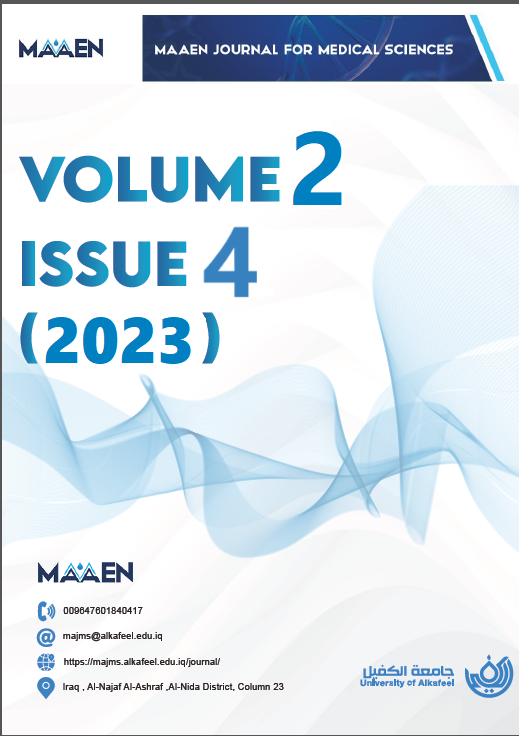Abstract
To obtain the full article please click the below URL or copy the URL and paste it in your browser
(https://majms.alkafeel.edu.iq/journal/vol2/iss4/1/)
Background: Oral lichen planus (OLP) is a chronic inflammatory condition affecting the oral mucosal surfaces of the
mouth. It affects between 1% and 2% of the general population. It is a potentially malignant disease, according to the
World Health Organization (WHO), with a worsening transformation prevalence of 0e1%. OLP\'s pathophysiology is
believed to be strongly associated to microbial infection, mental problems, allergic responses, and immunodeficiency,
despite the fact that its source is unknown.
The aim of study: To identify and explain the clinical manifestations, signs and symptoms of patients with oral lichen
planus disease (OLP).
Materials and methods: The study included 50 OLP patients who were selected through clinical examination in this
clinical investigation. Any individuals who were on medication, undergoing surgical procedures, pregnant, or suffering
from autoimmune disorders like Rheumatoid arthritis (Ra) or Systemic lupus erythematosus (SLE) were excluded from
this study. Standardized case sheets were used to record the demographics, medical, social, and pharmaceutical details of
each patient. Before treatment, the site, size, and type of each patient\'s oral lichen planus lesions were evaluated.
Results: The participants in this study were divided into two groups: group 1 (25) patients with oral lichen planus OLP
(17 females and 8 males) with a mean SD (47 ± 18.35) and group 2 (25) patients with OLP associated with skin lesions (14
females and 11 males) with a mean SD (45 ± 16.23) and an age range of (30e70) years old. Females accounted for (73.4%)
of OLP patients and (54.2%) of OLP with skin lesions patients, whereas males accounted for 26.6 percent of OLP patients
and 45.8% of OLP with skin lesions patients. The reticular form (73.4%) of OLP and (84.6%) of OLP with skin lesions
patients was the most common clinical form of oral lichen planus, followed by the erosive form (26.6%) of OLP and
(15.4%) of OLP with skin lesions patients. According to the clinical appearance of the lesions, the most usually afflicted
region was the buccal mucosa (82% in OLP and 86% in patients with OLP and skin lesions), followed by the tongue
(7%,12%) and gingiva (11%,2%) respectively.
Conclusion: In every group of the current study, the vast majority of patients with oral lichen planus pathology were
females, and the reticular kind of oral lichen planus was the most prevalent clinical manifestation, preceded by the
erosive kind. The buccal mucosa was the most usually affected area in OLP, followed by the gingiva and then the
tongue, based on the clinical characteristics of the lesions]. Patients with the erosive form of lesion had severe
discomfort, but others with the reticular type had mild to moderate symptoms. Each lesion resulted in complaints.
(https://majms.alkafeel.edu.iq/journal/vol2/iss4/1/)
Background: Oral lichen planus (OLP) is a chronic inflammatory condition affecting the oral mucosal surfaces of the
mouth. It affects between 1% and 2% of the general population. It is a potentially malignant disease, according to the
World Health Organization (WHO), with a worsening transformation prevalence of 0e1%. OLP\'s pathophysiology is
believed to be strongly associated to microbial infection, mental problems, allergic responses, and immunodeficiency,
despite the fact that its source is unknown.
The aim of study: To identify and explain the clinical manifestations, signs and symptoms of patients with oral lichen
planus disease (OLP).
Materials and methods: The study included 50 OLP patients who were selected through clinical examination in this
clinical investigation. Any individuals who were on medication, undergoing surgical procedures, pregnant, or suffering
from autoimmune disorders like Rheumatoid arthritis (Ra) or Systemic lupus erythematosus (SLE) were excluded from
this study. Standardized case sheets were used to record the demographics, medical, social, and pharmaceutical details of
each patient. Before treatment, the site, size, and type of each patient\'s oral lichen planus lesions were evaluated.
Results: The participants in this study were divided into two groups: group 1 (25) patients with oral lichen planus OLP
(17 females and 8 males) with a mean SD (47 ± 18.35) and group 2 (25) patients with OLP associated with skin lesions (14
females and 11 males) with a mean SD (45 ± 16.23) and an age range of (30e70) years old. Females accounted for (73.4%)
of OLP patients and (54.2%) of OLP with skin lesions patients, whereas males accounted for 26.6 percent of OLP patients
and 45.8% of OLP with skin lesions patients. The reticular form (73.4%) of OLP and (84.6%) of OLP with skin lesions
patients was the most common clinical form of oral lichen planus, followed by the erosive form (26.6%) of OLP and
(15.4%) of OLP with skin lesions patients. According to the clinical appearance of the lesions, the most usually afflicted
region was the buccal mucosa (82% in OLP and 86% in patients with OLP and skin lesions), followed by the tongue
(7%,12%) and gingiva (11%,2%) respectively.
Conclusion: In every group of the current study, the vast majority of patients with oral lichen planus pathology were
females, and the reticular kind of oral lichen planus was the most prevalent clinical manifestation, preceded by the
erosive kind. The buccal mucosa was the most usually affected area in OLP, followed by the gingiva and then the
tongue, based on the clinical characteristics of the lesions]. Patients with the erosive form of lesion had severe
discomfort, but others with the reticular type had mild to moderate symptoms. Each lesion resulted in complaints.
